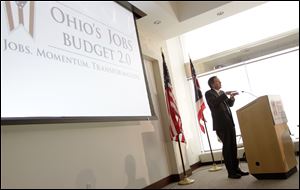
Ohio Budget
Lawmakers say Kasich tax plan, changes favor rich
2/6/2013
Ohio Gov. John Kasich's two-year, $66.3 billion budget calls for a net tax cut of $1.4 billion using a menu of income tax cuts for individuals and small business, a half-penny cut in the sales tax while broadly expanding the base on which it’s based, and hiking taxes on a burgeoning Utica shale drilling industry.
COLUMBUS — Now that it’s the lawmakers’ turn, Democrats on Tuesday wasted little time charging that the tax choices made by Gov. John Kasich in his just-unveiled budget plan amount to “big tax giveaways to the richest people in Ohio.”
State Rep. John Patrick Carney (D., Columbus), a member of the House Finance and Appropriations Committee, argued that Ohio went down this road in 2005 when it started a multi-year rollout of income and business tax reductions.
“The administration has essentially favored tax changes that disproportionately benefit the wealthy, whether it’s the elimination of the estate tax or whether it’s this income tax change …,” he said. “[Under the 2005 reforms], the top 1 percent of earners in Ohio got $9,556 from that cut. The lowest 20 percent got $19, but the average family in Ohio is below $181 …
“The tax cut that’s being proposed here looks like the average family gets about $50,” Mr. Carney said.
Mr. Kasich’s two-year, $66.3 billion budget calls for a net tax cut of $1.4 billion using a menu of income tax cuts for individuals and small business, a half-penny cut in the sales tax while broadly expanding the base on which it’s based, and hiking taxes on a burgeoning Utica shale drilling industry.
It also includes $416 million in automatic income tax rebates that would be triggered for this calendar year if lawmakers agree to use surpluses to run up the balance in the state’s rainy day fund reserves.
“Capital investment matters,” Mr. Kasich’s budget director, Tim Keen, told the committee. “Capital investment drives jobs. Taxation that punishes income is a disincentive for capital investment in the state of Ohio. We have very high marginal rates. We have local rates that drive that up …
“The intention behind this tax cut is to drive down tax rates, which will increase the after-tax return on capital invested in Ohio,” he said. “That is particularly why there’s a small-business tax cut at the heart of this proposal.”
Democrats, however, argued that the first priority of this budget should be undoing past cuts imposed on schools and local governments. They argued that the rationale for cutting them two years ago, a potential budget shortfall estimated by some at about $8 billion, no longer applies now that the state is predicting a fiscal year surplus approaching $1 billion. That doesn’t count $500 million that the state recently received from the lease of its lucrative liquor monopoly to its new JobsOhio economic development corporation.
As lawmakers continue hearings at the Statehouse, Mr. Kasich today will try to sell his plan to northwest Ohio with a visit to the Maumee corporate office of Service Spring Corp, a company that provides parts for the overhead garage door industry.
Mr. Kasich will lead a panel discussion with local small-business owners and economic experts before an invitation-only audience.
Lawmakers have begun what are expected to be months of legislative budget hearings. A new budget must reach Mr. Kasich’s desk before July 1.
State Rep. Michael Ashford (D., Toledo), a committee member, could be heard heaving an audible sigh upon hearing Mr. Keen note that a proposed severance tax hike targeting the horizontal, hydraulic fracturing wells would not apply to conventional vertical wells or to small-volume natural gas wells. He tied that to the current budget’s school and local government cuts.
“And then you turn around and you have one of the most profitable industries out there, gas and oil, not paying their fair share in taxes …,” he said. “I have some major concerns about it.”
He also questioned the sales tax plan. “Will the difference between a 5.5 percent sales tax and a 5.0 [percent] save the middle-income literally thousands and thousands of dollars? Absolutely not,” he said. “I think it’s a nice gesture, but it’s not really going to have an impact on your standard of living in your house.”
State Rep. Jeff McClain (R., Upper Sandusky), whose district stretches north to include part of eastern Seneca County, called Mr. Kasich’s proposal a “courageous budget, far-reaching and caring.”
In addition to his tax changes, Mr. Kasich’s proposal calls for the state to expand Medicaid to cover more currently underinsured Ohioans under the federal health-care law, drives a greater share of K-12 education funds toward poorer schools, and provides modest increases in funding for higher education, local governments, and libraries.
Contact Jim Provance at: jprovance@theblade.com or 614-221-0496.